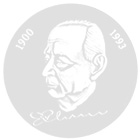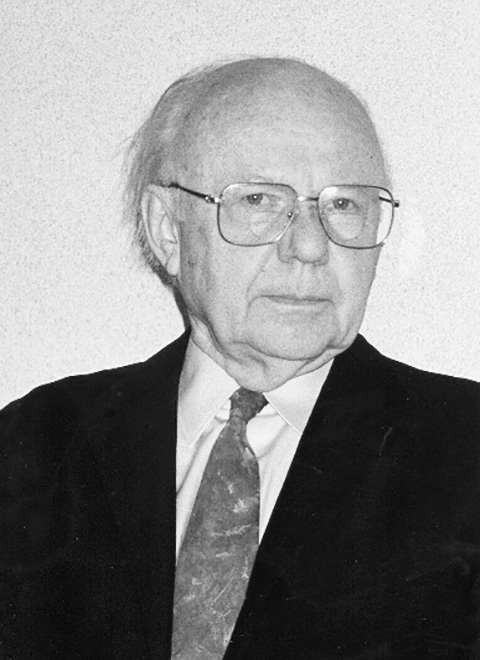Prof. Dr. Dr.h.c.mult. Heinz Zemanek
| 1.1.1920 | Geboren in Wien. |
| 1937-44 | Studium der Nachrichtentechnik an der TU Wien. |
| 1941-45 | Deutsche Wehrmacht; ab 1943 Radarentwicklung. |
| 1945-47 | Eigene Firmen. |
| 1947-61 | Universitätsassistent an der TU Wien; Dr. techn.1951 und ab 1959 Dozent. |
| 1964 | Außerordentlicher Professor an der TU Wien. |
| 1956-68 | Bau des Transistorcomputers “Mailüfterl” |
| 1961-75 | Direktor des IBM-Laboratoriums in Wien. |
| 1964-68 | Formale Definition von PL/I (VDL). |
| 1984 | Ordentlicher Professor an der TU Wien. |
| 1985-86 | Gastprofessor an der TU München. |
| 1988-89 | Vorlesungen an der Universität Stuttgart (SEL-Stiftung). |
| 1959-64 | Vorsitzender NTG Fachausschuß 6 (Informationsverarbeitung). |
| 1961-67 | Chairman IFIPTC2 (Programming Languages). |
| 1968-75 | IFlP Vicepresident, IFIP President, IFIP Past-President. |
| 1970-75 | Co-Chairman und Chairman FIACC. |
| 1975 | Gründungspräsident der Österreichischen Computergesellschaft. |
Mitgliedschaft in Akademien
Akadeiriie der Künste und Wissenschaften; Akademie der Künste Berlin-Brandenburg; Katholische
Akademie Wien.
Ehrungen
| 1960 | Preis der NTG |
| 1969 | Goldene Stefan-Ehrenmedaille des ÖVE. |
| 1969 | Goldene Stefan-Ehrenmedaille des ÖVE.. |
| 1970 | Fellow IEEE. |
| 1972 | Exner Medaille des ÖGV. |
| 1974 | Großes Ehrenzeichen für Verdienste um die Republik Österreich. |
| 1976 | IBM Fellow. |
| 1977 | IFIP Ehrenmitglied. |
| 1980 | Marin Drinow Medaille der Bulgarischen Akademie der Wissenschaft. |
| 1982 | Dr. techn.h.c. der Johannes Kepler Universität Linz. |
| 1984 | Leonardo da Vinci Medaille der SEFI. |
| 1985 | Die OCG stiftet den Heinz-Zemanek-Preis (zweijährlich). |
| 1986 | Großes Goldenes Ehrenzeichen für Verdienste um das Land Wien; zum IEEE Computerpionier gewählt; Dr. Ing. E. h. der Universität Erlangen-Nürnberg. |
| 1988 | Oskar von Miller Plakette des Deutschen Museums München. |
| 1989 | John von Neumann Medaille, Ungarn. |
| 1994 | Lotnonossow Medaille der Russischen Akademie der Wissenschaft. |
| 1997 | Bolzano Ring, Tschechi5che Republik; Titel eines Gastprofessors an der Donau Universität Krems. |
| 1998 | Auerbach Award der IFIP. |
.
Publikationen
Heinz Zemanek – a Life in the Service of Science
It is difficult to do justice to Heinz Zemanek’s accomplishments on a single page. A simple list of his speeches, publications, travels, and awards would be overwhelming in its length and diversity.
Heinz Zemanek’s major work, coming a decade after Konrad Zuse’s breakthrough, represents the transition from circuit engineering through programming technique to system design and thus encompasses the overall development of 20th-century computer science. What sets his work apart from other, merely technical contributions in the field is that he has always maintained a harmonious balance between the needs of the university, industry, and the (worldwide) computing association IFIP and that he has consistently emphasized the priority of the human factor.
In 1950 there was no national basis for computer development in Austria. Zemanek would later preface his report to the first comprehensive conference on the history of computer science in Los Alamos with the words “Tu felix Austria, nube,” a historical reference to Austria enlarging its empire through marriage instead of waging war; in this case, the “marriages” leading to the development of the computer were those of individual elements gathered from the neighboring nations Germany,
Switzerland, Hungary and Czechoslovakia, not to exclude the literature from the U.S., the U.K., Japan and Russia. For Zemanek, research has always meant more than the acquisition of technical information; even at this early stage, his fascination with the cultures and people of these nations was so pronounced that his network of contacts furthered communications between peoples for whom World War II still cast dark shadows, while simultaneously contributing to the interdisciplinary development of the modern field of computer science.
Konrad Zuse, who created the world’s first working computing system in 1941, was one of the mentors who welcomed Zemanek and actively supported his work (the construction of the fully transistorized computer “Mailüfterl,” or “spring breeze”). More than just colleagues, the two scientists became friends for life.
The international component of Zemanek’s Iife moved into the foreground as he established the IBM lab in Vienna and became active in IFIP the worldwide computing association. Parallel to the growth of his technical knowledge, his understanding of the meaning of this knowledge for the individual society and between peoples rapidly became deeper. He defined an independent position for himself that transeended both the Cold War and the international opposition to South Africa. With his typical
“Vienna touch,” an unaffected Austrian mixture of cordiality, incisiveness, humor, and concentration, Zemanek time and again managed to find solutions to divisive problems.
In his lifetime Heinz Zemanek has not only actively experienced the global aspect of information technology, he has also took countless large and small steps to bring together people of a11 races and nations. These efforts include his numerous speeches abroad, the moral support and expertise he has given to scientific associations in many different countries, to say nothing of his twelve books and more than 500 publications in many different languages.
Dipl.-Ing. Fritz Genser, KONRAD-ZUSE-GESELLSCHAFT

